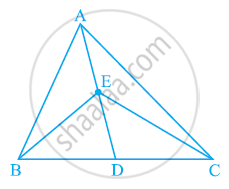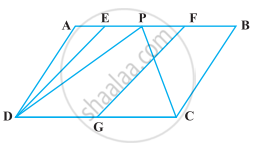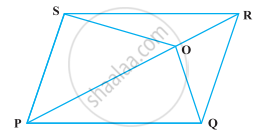Advertisements
Advertisements
Question
D, E and F are respectively the mid-points of the sides BC, CA and AB of a ΔABC. Show that
(i) BDEF is a parallelogram.
(ii) ar (DEF) = 1/4ar (ABC)
(iii) ar (BDEF) = 1/2ar (ABC)
Solution

(i) In ΔABC,
E and F are the mid-points of side AC and AB respectively.
Therefore, EF || BC and EF = 1/2BC (Mid-point theorem)
However, BD = 1/2BC (D is the mid-point of BC)
Therefore, BD = EF and BD || EF
Therefore, BDEF is a parallelogram.
(ii) Using the result obtained above, it can be said that quadrilaterals BDEF, DCEF, AFDE are parallelograms.
We know that diagonal of a parallelogram divides it into two triangles of equal area.
∴Area (ΔBFD) = Area (ΔDEF) (For parallelogram BD)
Area (ΔCDE) = Area (ΔDEF) (For parallelogram DCEF)
Area (ΔAFE) = Area (ΔDEF) (For parallelogram AFDE)
∴Area (ΔAFE) = Area (ΔBFD) = Area (ΔCDE) = Area (ΔDEF)
Also,
Area (ΔAFE) + Area (ΔBDF) + Area (ΔCDE) + Area (ΔDEF) = Area (ΔABC)
⇒ Area (ΔDEF) + Area (ΔDEF) + Area (ΔDEF) + Area (ΔDEF) = Area (ΔABC)
⇒ 4 Area (ΔDEF) = Area (ΔABC)
⇒ Area (ΔDEF) = 1/4Area (ΔABC)
(iii) Area (parallelogram BDEF) = Area (ΔDEF) + Area (ΔBDF)
⇒ Area (parallelogram BDEF) = Area (ΔDEF) + Area (ΔDEF)
⇒ Area (parallelogram BDEF) = 2 Area (ΔDEF)
⇒ Area (parallelogram BDEF)`= 2xx1/4"Area "(ΔABC)`
⇒ Area (parallelogram BDEF) = 1/2Area (ΔABC)
APPEARS IN
RELATED QUESTIONS
In the given figure, E is any point on median AD of a ΔABC. Show that ar (ABE) = ar (ACE)

In a triangle ABC, E is the mid-point of median AD. Show that ar (BED) = 1/4ar (ABC).
XY is a line parallel to side BC of a triangle ABC. If BE || AC and CF || AB meet XY at E and F respectively, show that
ar (ABE) = ar (ACF)
A villager Itwaari has a plot of land of the shape of a quadrilateral. The Gram Panchayat of the village decided to take over some portion of his plot from one of the corners to construct a Health Centre. Itwaari agrees to the above proposal with the condition that he should be given equal amount of land in lieu of his land adjoining his plot so as to form a triangular plot. Explain how this proposal will be implemented.
Diagonals AC and BD of a quadrilateral ABCD intersect each other at P. Show that ar (APB) × ar (CPD) = ar (APD) × ar (BPC).
[Hint : From A and C, draw perpendiculars to BD.]
PQRS is a parallelogram whose area is 180 cm2 and A is any point on the diagonal QS. The area of ∆ASR = 90 cm2.
In the following figure, ABCD and EFGD are two parallelograms and G is the mid-point of CD. Then ar (DPC) = `1/2` ar (EFGD).

O is any point on the diagonal PR of a parallelogram PQRS (Figure). Prove that ar (PSO) = ar (PQO).

The medians BE and CF of a triangle ABC intersect at G. Prove that the area of ∆GBC = area of the quadrilateral AFGE.
In ∆ABC, if L and M are the points on AB and AC, respectively such that LM || BC. Prove that ar (LOB) = ar (MOC)
